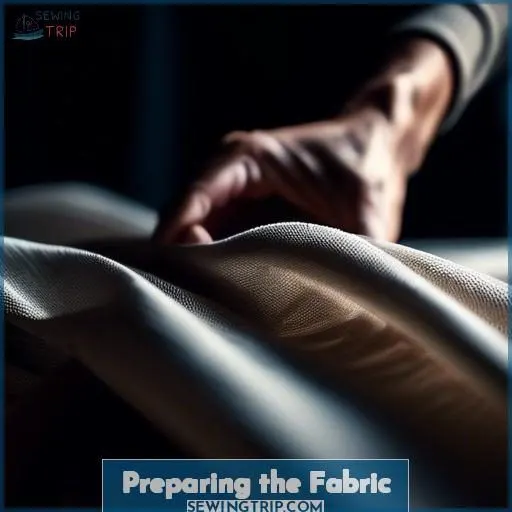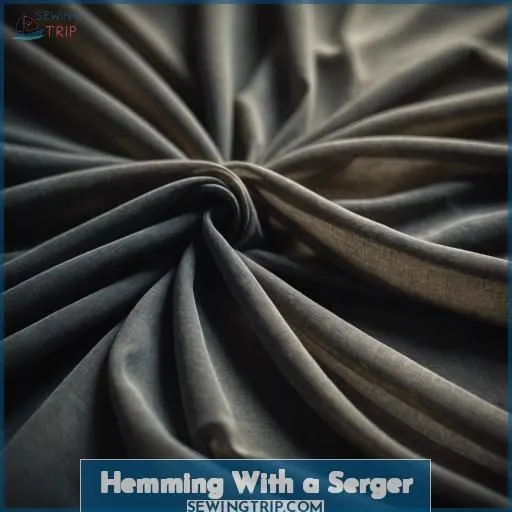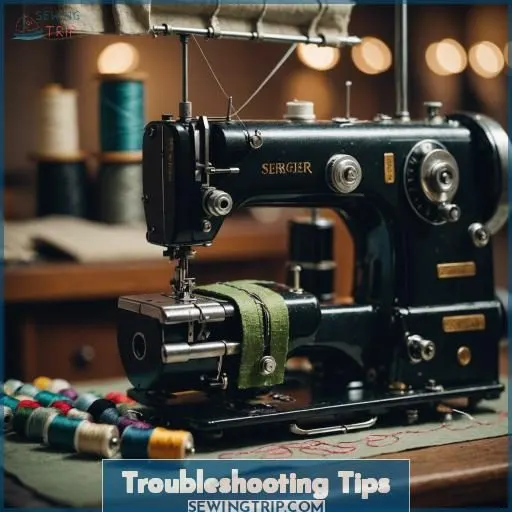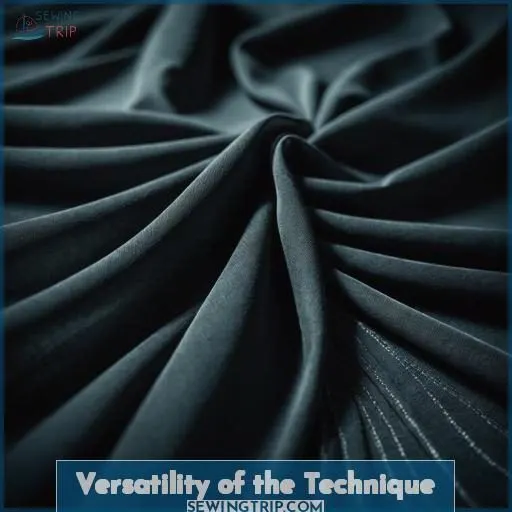This site is supported by our readers. We may earn a commission, at no cost to you, if you purchase through links.
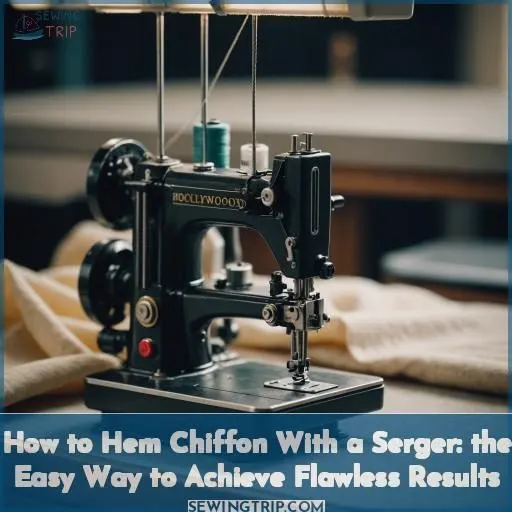 To hem chiffon with a serger, commence by severing the fabric along the straight grain and stabilizing the reverse side.
To hem chiffon with a serger, commence by severing the fabric along the straight grain and stabilizing the reverse side.
Append an overedge foot, modify tensions, establish the differential feed, and opt for a keen needle.
Serge the hem employing a balanced stitch and sharp needle.
Smooth the fold while serging, excise stabilizer, and detach it upon completion.
Apt thread tension and fabric selection guarantee longevity.
Troubleshoot by utilizing sharp needles, adjusting tensions and feeds to avert stretching or puckering.
Investigate creative touches such as rolled hems or ornamental stitches for exceptional finishes.
This versatile technique complements lightweight fabrics – persist for impeccable results.
Table Of Contents
Key Takeaways
- Stabilize the fabric with a lightweight wash-away stabilizer to prevent jamming and ensure a smooth, even hem
- Adjust serger settings like thread tension, differential feed, and stitch length to achieve balanced stitches and prevent stretching or puckering
- Use a sharp needle and guide the fabric smoothly to serge the hem, experimenting with rolled hem variations and decorative stitches for a professional finish
- This versatile technique works well for a variety of lightweight fabrics beyond chiffon, allowing you to adjust the hem width to suit your project’s needs
How to Hem Chiffon With a Serger?
To hem chiffon with a serger, first prepare the fabric by cutting it to size and stabilizing it. Then, set up your serger, serge the hem, and finish it off for a flawless result. This technique is versatile and suitable for various fabrics, allowing you to adjust the hem width as needed.
Preparing the Fabric
To prepare the chiffon fabric for serger hemming, begin by cutting the chiffon along the straight grain with sharp scissors, ensuring the cut edge is even and not distorted. Next, apply a lightweight wash-away stabilizer to the wrong side of the fabric along the raw edge; this will provide the necessary support for the delicate chiffon when serging.
Cutting the Chiffon
To begin, trim your chiffon fabric to the desired length using sharp fabric shears or a rotary blade. Guarantee the edges are straight and uniform by:
- Doubling the fabric lengthwise and snipping along the fold
- Using a measuring tape or straight edge to steer your cuts
- Trimming from the selvage edge to the raw edge in one fluid motion
- Snipping on a flat, stable surface to uphold a straight line
Stabilizing the Fabric
To stabilize chiffon for serger hemming, apply a wash-away stabilizer to the wrong side. Let it dry completely before proceeding. This prevents fabric jamming and guarantees a smooth, even hem. The stabilizer will easily wash out later, leaving no residue. Experiment with different stabilizers to find the best adhesive strength and removal ease for your fabric, whether it’s chiffon, cotton voile, or crepe de chine.
- Wash-away stabilizer prevents jamming
- Stabilizer dries completely before hemming
- Guarantees smooth, even serger hem
- Easily washes out with no residue
- Suitable for chiffon, voile, crepe de chine
Hemming With a Serger
Establishing your serger precisely is imperative for flawless hemming. Modify the settings in accordance with your fabric’s weight and nature, ensuring the blade is aligned to trim the seam allowance cleanly. When serging the hem, guide the fabric smoothly underneath the presser foot, enabling the serger’s blades to overlock the raw edge while you stitch.
Setting Up the Serger
To set up your serger for hemming chiffon, attach the overedge foot, adjust thread tensions, and optimize differential feed and stitch length settings. Use a sharp 65/9 needle. Make sure the right side of the fabric faces down, and the raw edge is folded 1/4 inch towards the wrong side, then folded again to create a double fold.
- Attach overedge foot
- Adjust thread tensions
- Set differential feed
- Select 65/9 sharp needle
- Optimize stitch length
Serging the Hem
With your chiffon fabric prepped and stabilized, it’s time to serge that hem! Choose a sharp serger needle to pierce the delicate fabric without snagging. Adjust your thread tension to achieve a balanced stitch, and experiment with rolled hem variations for a professional finish. Get creative with decorative stitches or binding options to add a unique touch to your chiffon masterpiece!
- Serger needle choice: sharp for delicate fabrics
- Thread tension adjustment: balanced stitches
- Rolled hem variations: professional finishes
- Decorative stitches: add creative flair
- Binding options: unique touches
Finishing the Hem
To complete the hem, gently pull the fabric in your direction to smooth the fold as you serge.
Snip away any leftover stabilizer from the hem, taking care not to trim the fabric.
Finally, gingerly detach the stabilizer from the fabric, revealing an impeccable, polished hem.
The glue’s potency and stabilizer options, combined with suitable thread tension and fabric selection, guarantee a long-lasting, superior finish.
Troubleshooting Tips
You’ll want to take care to prevent jamming when serging on chiffon. Using a lightweight stabilizer underneath the fabric can help tremendously. Achieving consistent folds is also key – you may need to tug the fabric gently as you sew to keep the folds flat and even.
Preventing Jamming
To prevent jamming when hemming chiffon with a serger, use a sharp 65/9 needle, adjust thread tensions, confirm the correct looper thread path, and adjust differential feed if fabric is stretching or puckering. Stabilize the fabric underneath to provide support and prevent jamming. Experiment with different settings to find the ideal combination for your serger and fabric.
Achieving Consistent Folds
To achieve consistent folds when hemming chiffon with a serger, adjust the tension, choose a suitable needle, and use the right stabilizer. Experiment with different settings and materials to find the perfect combination for your fabric. With some practice, you’ll master the art of flawless chiffon hems in no time!
Versatility of the Technique
You’ll find that this serging technique works well for a variety of lightweight fabrics beyond chiffon, such as organza, georgette, and silk crepes. Additionally, you can easily adjust the hem width by changing the initial fold measurements, allowing you to create narrow or wide hems to suit your project’s needs.
Suitable Fabrics
The beauty of this serging technique lies in its versatility. It effortlessly handles delicate fabrics like chiffon, cotton voile, and crepe de chine, allowing you to create stunning hems with precision. The narrow double fold adds a professional touch, making it ideal for sheer materials. Embrace your creativity and explore the endless possibilities of serging delicate fabrics with this easy-to-master method.
- Elevate your chiffon garments with a serged hem that exudes elegance.
- Discover the joy of hemming cotton voile with a technique that preserves its airy charm.
- Conquer the challenge of crepe de chine with a serged hem that drapes beautifully.
Hem Width Variations
Adjust the hem width to suit your fabric type and desired look. Eyeball 1/4 inch fold measurements for a narrow hem on cotton voile, or double the fold for a wide hem on crepe de chine. Experiment with stabilizer selection and serger settings to achieve consistent folds without jamming, regardless of fabric weight or hem width.
Frequently Asked Questions (FAQs)
Can I use regular thread in my serger for hemming?
You can use regular thread, but it’s better to use serger thread. It’s specially engineered for stretching without breaking during overlocking. This guarantees your hems stay secure over time.
How do I prevent wavy, stretched out serged hems on knits?
You’ll prevent wavy knits by stabilizing stretchy fabric first. Use a spray adhesive or lightweight tear-away stabilizer, then serge carefully without excessive tension. A serger machine’s differential feed balances stretching too.
What is the difference between overlock and regular sewing thread?
Overlock thread is thicker, stretchy, and designed for sergers to create durable seams. Regular sewing thread is thinner, less elastic, and meant for standard sewing machines. You’ll achieve superior results by using the appropriate thread for each machine.
Do I need a special foot for blind hemming with a serger?
You’ll need a special blind hem foot to easily achieve a blind hem stitch on your serger. This specialized foot guides fabric perfectly to achieve that coveted invisible catchstitch.
How do I adjust my sergers differential feed for hemming?
Did you know sergers stitch almost a mile of thread per day? To adjust the differential feed, refer to your manual. But usually, increasing it prevents waving while decreasing avoids puckering. Experiment until the fabric flows smoothly through the serger.
Conclusion
Mastering the craft of how to hem chiffon with a serger opens a realm of potential, converting the most ethereal fabrics into captivating garments. With exactness and meticulousness, you’ll effortlessly attain impeccable outcomes, propelling your sewing prowess to unprecedented levels. Embrace this adaptable method, and grant your imagination wings, creating exquisite pieces that attest to your impeccable artistry.

